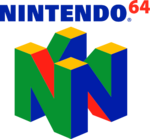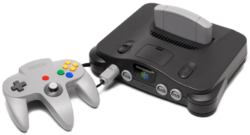From NintendoWiki, your source on Nintendo information. By fans, for fans.
Nintendo 64
ニンテンドー64 Nintendō Rokujūyon, NINTENDO64
|
|
|
| No. of games
|
387 (as of August 14, 2007)
|
| No. of launch titles
|
{{{launch_games}}}
|
| Best-selling game
|
Super Mario 64 (11 million copies as of May 21, 2003)
|
| Last game
|
Tony Hawk's Pro Skater 3 (August 20, 2002)
|
|
|
|
|
|
|
| Launch date
|
- NA - September 29, 1996
- JP - June 23, 1996
- EU - March 1, 1997
- AUS - March 1, 1997
|
| Discontinue date
|
2002
|
| Units sold
|
- Worldwide - 32.93 million
- NA - 20.63 million
- JP - 5.54 million
- EU/AUS - 6.75 million
|
|
|
|
The Nintendo 64 (ニンテンドー64, Nintendō Rokujūyon, NINTENDO64) was a video game console created by Nintendo. It was released in 1996 to compete with the Sega Saturn and PlayStation.
The Nintendo 64 was very popular for many reasons, one of the big ones being the release of Super Mario 64. Super Mario 64 was one of the first games of its kind to feature full 3D graphics and depth of field effects. The Nintendo 64 was able to pull this off because it was the first system to feature a 64-Bit processor and 32-bit graphics chip (aside from the failed Atari Jaguar, which was really 32-bit) The Nintendo 64 also featured the first successful analog control sticks, and four built-in controller ports. The Nintendo 64 was also noted as the last home console system to use cartridges, before Nintendo started using discs like it's competitors.
The Nintendo 64 hosted a wide variety of games, but most of its hits were first-party titles such as Super Mario 64, Super Smash Bros., Mario Kart 64, Mario Party, Star Fox 64, Legend of Zelda: Ocarina of Time and F-Zero X. Rareware, however, developed quite a few hits for the N64, such as Goldeneye 007, Banjo-Kazooie and Donkey Kong 64. Production ended in 2002, the last game released for it being Tony Hawk's Pro Skater 3
System specs
Processors:
CPU: MIPS 64 bit Risc CPU, (R4300I series) 93.75 MHz
Graphics 64-bit MIPS Risc Co-processor, GSP & DP, 62.5 MHz (RCP)
Built-in Audio/Video Vector Processor (RSP)
Built-in Pixel Drawing Processor (RDP)
Transmission Speed:
Maximum of 4 500 Mbit/second
Memory:
4.5 MB Rambus DRAM (36 megabits)
Rambus DRAM subsystem
Custom 9-bit Rambus Bus (to the DRAM)
Video:
Resoloutions: 256x224 to 640x480. PAL also 768x576
Video Output: RF, Stereo A/V, S-Video
Color:21-bit color video output, 32-bit RGPA, pixel colour frame
buffer support
Audio:
Digital Sound
Wavetable Synthesis
Major Special Features:
Perspective correct texture-mapping
Realtime Anti-Aliasing
Tri-Linear Mip-Mapping
Z-Buffering
Flicker-free interlaced mode support
Expansion Options:
Cartridge Slot
Controller Ports
Pak Holder (Controller)
Extension port (Bottom)
Memory Expansion Option (Top Front)
Dimensions:
Width 260mm (10.23") x Depth 190mm (7.48") x Height 73mm (2.87")
2.42 lbs (1.1kg)
Games
Accessories
References
The Nintendo 64 has made a few appearances in Mario games as an easter egg. A Nintendo 64 appears in Super Smash Bros. Melee in the background of the stand where all of the player's trophies are. Francis, from Super Paper Mario also owns a Nintendo 64 as well as a Nintendo GameCube, Virtual Boy and Wii. In Super Smash Bros. Brawl, one of the names that can appear whenever a player presses the random button when they're naming their custom stage is N64, which is a reference to the old system.
See Also

|
This article is a stub. You can help NintendoWiki by expanding it.
|
|
|
|
|
|
|
| Other
|
| Standalone consoles
|
Arcade
|
Pokémon
|
Classics
|
Cancelled
|
|
|
|
|
|
|
|



